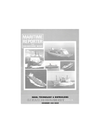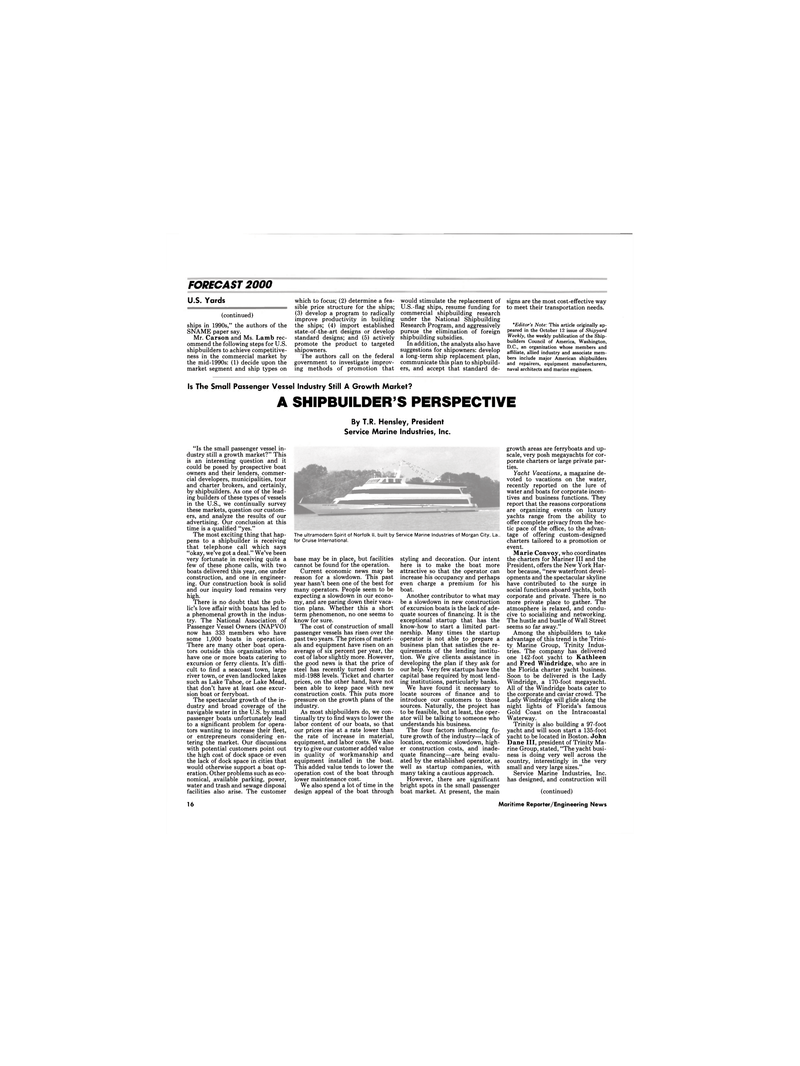
Page 14: of Maritime Reporter Magazine (December 1989)
Read this page in Pdf, Flash or Html5 edition of December 1989 Maritime Reporter Magazine
FORECAST 2000
U.S. Yards (continued) ships in 1990s," the authors of the
SNAME paper say.
Mr. Carson and Ms. Lamb rec- ommend the following steps for U.S. shipbuilders to achieve competitive- ness in the commercial market by the mid-1990s: (1) decide upon the market segment and ship types on which to focus; (2) determine a fea- sible price structure for the ships; (3) develop a program to radically improve productivity in building the ships; (4) import established state-of-the-art designs or develop standard designs; and (5) actively promote the product to targeted shipowners.
The authors call on the federal government to investigate improv- ing methods of promotion that would stimulate the replacement of
U.S.-flag ships, resume funding for commercial shipbuilding research under the National Shipbuilding
Research Program, and aggressively pursue the elimination of foreign shipbuilding subsidies.
In addition, the analysts also have suggestions for shipowners: develop a long-term ship replacement plan, communicate this plan to shipbuild- ers, and accept that standard de- signs are the most cost-effective way to meet their transportation needs. *Editor's Note: This article originally ap- peared in the October 12 issue of Shipyard
Weekly, the weekly publication of the Ship- builders Council of America, Washington,
D.C., an organization whose members and affiliate, allied industry and associate mem- bers include major American shipbuilders and repairers, equipment manufacturers, naval architects and marine engineers.
Is The Small Passenger Vessel Industry Still A Growth Market?
A SHIPBUILDER'S PERSPECTIVE
By T.R. Hensley, President
Service Marine Industries, Inc. "Is the small passenger vessel in- dustry still a growth market?" This is an interesting question and it could be posed by prospective boat owners and their lenders, commer- cial developers, municipalities, tour and charter brokers, and certainly, by shipbuilders. As one of the lead- ing builders of these types of vessels in the U.S., we continually survey these markets, question our custom- ers, and analyze the results of our advertising. Our conclusion at this time is a qualified "yes."
The most exciting thing that hap- pens to a shipbuilder is receiving that telephone call which says "okay, we've got a deal." We've been very fortunate in receiving quite a few of these phone calls, with two boats delivered this year, one under construction, and one in engineer- ing. Our construction book is solid and our inquiry load remains very high.
There is no doubt that the pub- lic's love affair with boats has led to a phenomenal growth in the indus- try. The National Association of
Passenger Vessel Owners (NAPVO) now has 333 members who have some 1,000 boats in operation.
There are many other boat opera- tors outside this organization who have one or more boats catering to excursion or ferry clients. It's diffi- cult to find a seacoast town, large river town, or even landlocked lakes such as Lake Tahoe, or Lake Mead, that don't have at least one excur- sion boat or ferryboat.
The spectacular growth of the in- dustry and broad coverage of the navigable water in the U.S. by small passenger boats unfortunately lead to a significant problem for opera- tors wanting to increase their fleet, or entrepreneurs considering en- tering the market. Our discussions with potential customers point out the high cost of dock space or even the lack of dock space in cities that would otherwise support a boat op- eration. Other problems such as eco- nomical, available parking, power, water and trash and sewage disposal facilities also arise. The customer
The ultramodern Spirit of Norfolk II, built by Service Marine Industries of Morgan City, La., for Cruise International. base may be in place, but facilities cannot be found for the operation.
Current economic news may be reason for a slowdown. This past year hasn't been one of the best for many operators. People seem to be expecting a slowdown in our econo- my, and are paring down their vaca- tion plans. Whether this a short term phenomenon, no one seems to know for sure.
The cost of construction of small passenger vessels has risen over the past two years. The prices of materi- als and equipment have risen on an average of six percent per year, the cost of labor slightly more. However, the good news is that the price of steel has recently turned down to mid-1988 levels. Ticket and charter prices, on the other hand, have not been able to keep pace with new construction costs. This puts more pressure on the growth plans of the industry.
As most shipbuilders do, we con- tinually try to find ways to lower the labor content of our boats, so that our prices rise at a rate lower than the rate of increase in material, equipment, and labor costs. We also try to give our customer added value in quality of workmanship and equipment installed in the boat.
This added value tends to lower the operation cost of the boat through lower maintenance cost.
We also spend a lot of time in the design appeal of the boat through styling and decoration. Our intent here is to make the boat more attractive so that the operator can increase his occupancy and perhaps even charge a premium for his boat.
Another contributor to what may be a slowdown in new construction of excursion boats is the lack of ade- quate sources of financing. It is the exceptional startup that has the know-how to start a limited part- nership. Many times the startup operator is not able to prepare a business plan that satisfies the re- quirements of the lending institu- tion. We give clients assistance in developing the plan if they ask for our help. Very few startups have the capital base required by most lend- ing institutions, particularly banks.
We have found it necessary to locate sources of finance and to introduce our customers to those sources. Naturally, the project has to be feasible, but at least, the oper- ator will be talking to someone who understands his business.
The four factors influencing fu- ture growth of the industry—lack of location, economic slowdown, high- er construction costs, and inade- quate financing—are being evalu- ated by the established operator, as well as startup companies, with many taking a cautious approach.
However, there are significant bright spots in the small passenger boat market. At present, the main growth areas are ferryboats and up- scale, very posh megayachts for cor- porate charters or large private par- ties.
Yacht Vacations, a magazine de- voted to vacations on the water, recently reported on the lure of water and boats for corporate incen- tives and business functions. They report that the reasons corporations are organizing events on luxury yachts range from the ability to offer complete privacy from the hec- tic pace of the office, to the advan- tage of offering custom-designed charters tailored to a promotion or event.
Marie Convoy, who coordinates the charters for Mariner III and the
President, offers the New York Har- bor because, "new waterfront devel- opments and the spectacular skyline have contributed to the surge in social functions aboard yachts, both corporate and private. There is no more private place to gather. The atmosphere is relaxed, and condu- cive to socializing and networking.
The hustle and bustle of Wall Street seems so far away."
Among the shipbuilders to take advantage of this trend is the Trini- ty Marine Group, Trinity Indus- tries. The company has delivered one 142-foot yacht to Kathleen and Fred Windridge, who are in the Florida charter yacht business.
Soon to be delivered is the Lady
Windridge, a 170-foot megayacht.
All of the Windridge boats cater to the corporate and caviar crowd. The
Lady Windridge will glide along the night lights of Florida's famous
Gold Coast on the Intracoastal
Waterway.
Trinity is also building a 97-foot yacht and will soon start a 135-foot yacht to be located in Boston. John
Dane III, president of Trinity Ma- rine Group, stated, "The yacht busi- ness is doing very well across the country, interestingly in the very small and very large sizes."
Service Marine Industries, Inc. has designed, and construction will (continued) 16 Maritime Reporter/Engineering News

 13
13

 15
15
